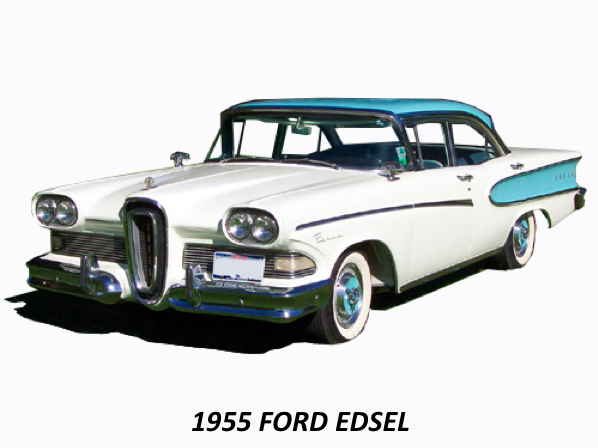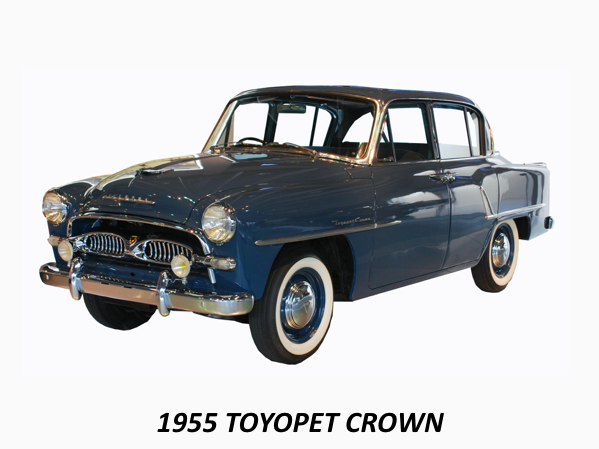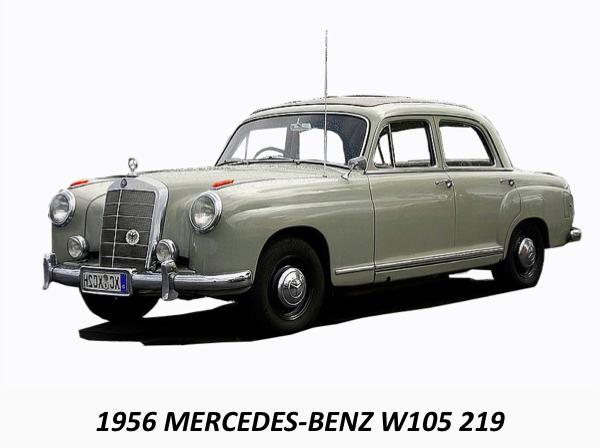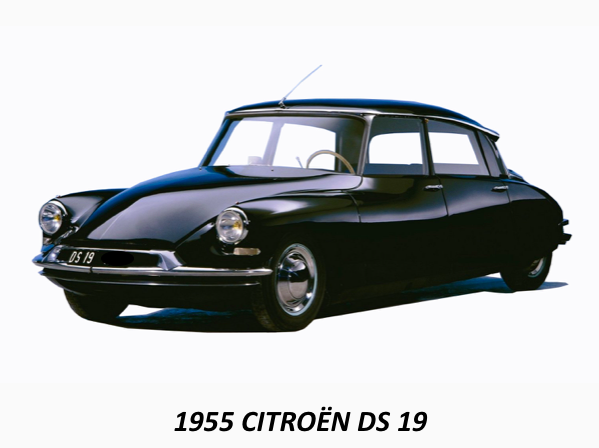This is a story of design failure in the United States of America*. It follows last week’s analysis of how the USA as a country was designed to fail, in its constitution and beliefs, based as it is on individualism and exceptionalism. And that original design failure of hubris has led to some spectacularly failed designs.
Today's analysis is through the prism of automotive design, looking at four cars from 1955, 10 years after the end of WW2; from the winners, USA, from the vanquished, Japan and Germany, and from France for some design beauty. All the cars are 4-5 seat ‘family sedans’, but in every other aspect they are very different. Let's start with the Edsel, a car that Ford, one of the big three manufacturers along with General Motors and Chrysler, hoped would revolutionize their industry. It was named after the son of founder Henry Ford, who almost single-handedly invented the production line that had served the USA so well during the war effort. The Edsel was big, very big, as were most USA designs were becoming. Long, at 18’3” and heavy, it weighed in at 4,500 lbs. The US still refuses to metricise, so for the sake of comparison that’s 5.56 m and just over 2000 kilograms. As we shall see, the car was an utter failure lasting only two years before the bad press and failure of sales had it withdrawn from the market.
Let's start with the Edsel, a car that Ford, one of the big three manufacturers along with General Motors and Chrysler, hoped would revolutionize their industry. It was named after the son of founder Henry Ford, who almost single-handedly invented the production line that had served the USA so well during the war effort. The Edsel was big, very big, as were most USA designs were becoming. Long, at 18’3” and heavy, it weighed in at 4,500 lbs. The US still refuses to metricise, so for the sake of comparison that’s 5.56 m and just over 2000 kilograms. As we shall see, the car was an utter failure lasting only two years before the bad press and failure of sales had it withdrawn from the market. The Toyota motor company was founded in 1937 just before WW2, but the devastation in Japan caused Toyota to rethink everything about its car industry, which may well have been fortunate. It launched its flagship, the Toyopet Crown, in 1955, calling all its models after a crown: including the Corona (not the virus) and the Corolla (Latin for a small crown). It was a small sedan, 4.29 m long and weighed 1,152 kg, suitable for the local population and crowded cities. The Crown was conservative in styling, Toyota putting more store in quality than size, paralleling companies such as Sony.
The Toyota motor company was founded in 1937 just before WW2, but the devastation in Japan caused Toyota to rethink everything about its car industry, which may well have been fortunate. It launched its flagship, the Toyopet Crown, in 1955, calling all its models after a crown: including the Corona (not the virus) and the Corolla (Latin for a small crown). It was a small sedan, 4.29 m long and weighed 1,152 kg, suitable for the local population and crowded cities. The Crown was conservative in styling, Toyota putting more store in quality than size, paralleling companies such as Sony. Mercedes-Benz introduced this family car in Germany in 1956, as the W105, also known as the 219. No nonsense arithmetically functional names. It was 4.65 m long and weighed 1,290 kilograms and was made for three years, between 1956 and 59 in several variants. It was a four-door, front engine, rear drive sedan or saloon using a straight six motor.
Mercedes-Benz introduced this family car in Germany in 1956, as the W105, also known as the 219. No nonsense arithmetically functional names. It was 4.65 m long and weighed 1,290 kilograms and was made for three years, between 1956 and 59 in several variants. It was a four-door, front engine, rear drive sedan or saloon using a straight six motor.
From 1953 Daimler Benz had used ‘Ponton’ styling on its cars (‘Pontoon’ in German). This was a prominent styling trend of the time that sought to unify a car’s previously articulated with a hood, body, fenders and running boards into a singular envelope. It was the beginnings of streamlining. Our fourth car is from France, designed in the years after the second world war by engineer André Lefèvre and draftsman and sculptor Flaminio Bertoni, under direction of André Citroën. Every part was rethought: the body, the interior, the engine, the styling and the most radical part: the hydraulic suspension.
Our fourth car is from France, designed in the years after the second world war by engineer André Lefèvre and draftsman and sculptor Flaminio Bertoni, under direction of André Citroën. Every part was rethought: the body, the interior, the engine, the styling and the most radical part: the hydraulic suspension.
The Citroën DS was launched in 1955 with a curb weight of 1,215 kilos and was 4.81 meters long, driven by a four-cylinder engine through the front wheels, which Citroën had pioneered in its pre-war Traction Avant, literally the front grip or front drive. The base set-up lasted for 20 years until 1975 with minor modification to the headlights and trim. DS is a ‘jeux de mots’ or pun, when said in French it sounds like Goddess, a name by which it universally known.
The Design Failure
Prior to the war the USA had led the way in automotive design and manufacture. Ten years later, as we shall see, they had forfeited almost everything. The figures tell one part of the story: The Ford Edsel was almost 25 percent longer and 65 percent heavier than its Japanese and European rivals.
This extra length and weight distorts everything; the motor needs to be 50 percent larger and far less fuel efficient just to move it around; carports and garages have to be bigger, hence USA homes have a much bigger footprint than European or Japanese counterparts; car parks in shopping malls have to be 20 percent bigger to accommodate the larger car and turning circle; and the extra width requires wider roads, not only on suburban surface streets, but crucially on the newly developed freeways, not only in LA, but across the whole USA.
But figures are only part of the story: all that weight gives terrible, sometimes dangerous, handling; it relies on outmoded leaf spring suspension and shock absorbers compared the hydraulic suspension in the Citroen DS or the more nimble Crown or Merc; it had a complete lack of safety features; and it was ugly, really awfully ugly, all the way from its clunky oval mouth at the front to its incipient fins at the rear.
Ralph Nader led a consumer backlash in his seminal book ‘Unsafe at Any Speed’. Every part of the design was picked over and publicly criticized and it produced two outcomes: Ford withdrew the car from sale in less than two years; and the furore gave rise to the new business of consumer advocacy, in which Ralph Nader became the byword.
Despite every aspect of the Edsel being ridiculed, and its poor sales, the response of the American auto industry was to go harder. Bigger V8 engines (“the only thing better than cubic inches is cubic feet”) and revised styling with more and bigger fins and extra chrome to extend the space age imagery of the car going inter-galactic. They sold well in a country craving gauche status symbols, so there are still many to be seen in obscure muscle car events or being used as novelty wedding cars.
Meanwhile, the design of the Toyota, Mercedes and Citroën have continued with evolving modifications and improved safety features, particularly incorporating seatbelts, airbags and ABS braking (viva Volvo that leads the way).
The Process Failure
The Ford Edsel, and all subsequent USA cars, were also a failure of manufacturing process. Detroit and other car manufacturing centres continued use the same production line that Ford had pioneered for the model T. Meanwhile in Japan, a completely different approach was being trialled; with less space available, and a greater regard for cost reduction, the Japanese pioneered ‘lean production’.
There was no manufacturing plant, but rather an assembly line that pulled in parts from all over the country, made by individual specialist contractors to meet the highest possible standards for that part. A car ‘assembled’ in such a way is flexible: changes can be made quickly, a variety of orders can be met, and gradual design improvements initiated.
This process was analysed by the Massachusetts Institute of Technology in a $5 million, five-year study on the future of the automobile and published in ‘The Machine That Changed the World’, released in 1990.
But the lessons weren't learned in the USA which steadfastly held on to the production line, making ever more cumbersome cars such as the GM Crown Victoria, a car available to the public but more often seen loping down the streets of New York as a police car or taxi, a long wheel-base version with extra room for passengers or crims.
The Asian makers such as Honda, Nissan, Mazda, Hyundai and Kia adopted lean production as did some European companies, following the lead of the world’s most successful maker Toyota.
EV: The Tesla failure
Tesla, the most recent and disruptive entry to the USA automotive industry has not strayed far from the failures of the Ford Edsel: its cars are unnecessarily large and bulky, intended to appeal to the luxury end of the market. And it is made almost entirely by Tesla using its own in-house parts, as Elon Musk demands. The Tesla S or X can fit well in the oversized garages, parking lots and freeways, but they are bulky cars, ill-suited to European or Asian streets. The high sales rate in Norway is only a result of heavy subsidies.
In contradistinction, the Toyota Prius or moreover the Nissan Leaf, the Hyundai Kona and Ioniq, and particularly the BMW I3 are far smaller, just as efficient and half the price; and mostly made on lean production. We don’t see this; more Nissan Leaf cars have been sold in the more EV progressive NZ than in the whole of Australia, despite its value.
The exceptionalism of America demands the biggest, the individuality of America demands the largest. It's 65 years on from the failure of the Ford Edsel and it would appear that American designers, even the best at Tesla, haven't listened or learned the lessons of beauty, elegance and simplicity; lean design and manufacture. Small is beautiful.
One Final Failure
And speaking of hubris and not learning lessons, the aforementioned Ralph Nader stood as a 3rd candidate in the presidential election in 2000, stealing just enough votes from Al Gore to ensure the most progressive and sustainable candidate, not to say consumer advocate, would be denied. History repeated in Bob Brown’s caravan of lunacy into Queensland last year to deny yet again the possibility of Labor derived climate action. Less Hubris, more humility. Works just as well in politics as it does in car design.
* USA is used here, not ‘America’ which can refer to some 25 countries, and not ‘United States’, since it’s neighbour to the south is also a ‘United States’: Estados Unidos Mexicanos.
Tone Wheeler is principal architect at Environa Studio, Adjunct Professor at UNSW and is President of the Australian Architecture Association. The views expressed here are solely those of the author and are not held or endorsed by A+D, the AAA or UNSW. Tone does not read Instagram, Facebook, Twitter or Linked In. Sanity is preserved by reading and replying only to comments addressed to [email protected]

